![]()
The Words of the Yano Family
|
|
The Words of the Yano Family |
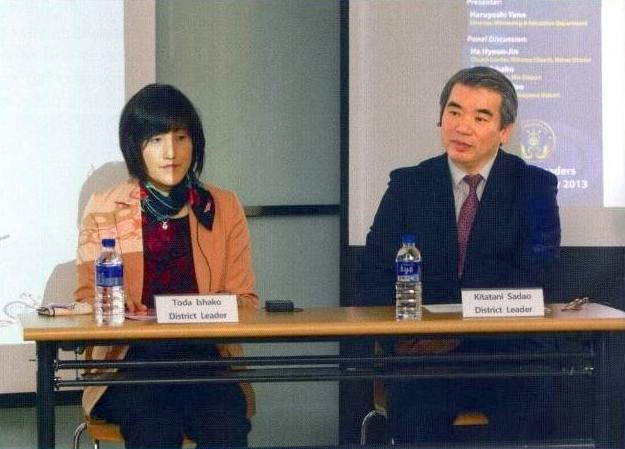
District
Leaders: Mrs. Toda works in Suzuka; Mr. Kitatani is active in
Wakayama.
Historically, Japan had adhered to an idealized conception of the multigenerational family that extends back through the father's ancestral line and into the future through his sons (specifically, his first son) and includes other relatives living nearby. In the first census taken of the Japanese population, in 1920, more than 30 percent of homes were multigenerational. Typically, this would have included the nuclear family and the father's parents or even his parents and grandparents and his grandchildren (five generations). Yet, tornadic forces -- economic upheaval combined with abrupt changes in social norms and expectations -- have torn through Japanese society as they have all other cultures in modern times. Today, the most rapidly growing categories of home ownership in Japan are not for families of any type but for single occupants or couples without children.
In a January 2013 Asahi Shimbun article, Mr. Koichi Hamai, a social scientist, was quoted as saying, "Japan may seem like a cute and polite nation but the societal problems that plague the country are similar to the ones in the West." Homelessness is still rare in Japan and the number of suicides fell substantially in 2012, but several other social phenomena point to inner desperation of people seeking escape. In a 2005 study of OECD' nations, Japan had the highest percentage (15.3 percent) of people that rarely socialized with friends, colleagues or other groups and the second highest (1.7 percent) that never socialized.
In an extreme form of isolation, hikikomori ("pulled inside"), severely isolated youth and some adults refuse to leave home or even leave a particular room within a home.
Futoko is a term used for elementary, middle and high school students who adamantly refuse to go to school. Perhaps because the adults involved believe some form of extreme humiliation or bullying is involved, the students are not expelled but go from year to year only on paper until they eventually graduate.
Makeinu (loser dog") has been an insult for a woman who did not marry but is sometimes now used proudly as a self-description by businesswomen whose hearts cannot be satisfied by life under the restrictions that their mothers' generation endured. Their refusal to marry exacerbates Japan's problems of a low birthrate and in turn its swiftly aging society. Though the focus of the new use of makeinu is women that defiantly embrace spinsterhood, the percentage of men who fall into the "lifetime singles" category is increasing at an even more dramatic pace than that of women.
None of these conditions is common; they are odd exceptions, social phenomena of a type that the news media is likely to bring to the public's awareness in any country. Yet, especially during precarious economic times, even hearing of fellow citizens suffering from these and other odd maladies can be unsettling. They prompt introspection about the health of one's nation: Are these symptoms of some more serious underlying problems in our society? What does the future hold?
In their disturbing nature, news reports of such abnormal behavior parallel the "wars and rumors of wars" that the Bible speaks of. They are "birth pangs" of a new beginning to be ushered in by the returning Lord.
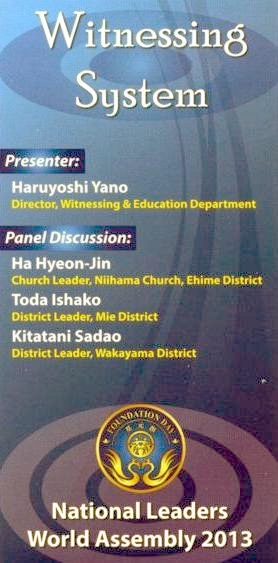
In doing the analysis necessary to develop witnessing systems that work, the Japanese movement recognizes that Japan's societal unease, particularly as it relates to the state of the family, is a situation favorable to their efforts to increase membership. Japanese members' efforts have yielded consistent growth, greater growth than elsewhere. For this reason, Japanese church leaders were asked to speak about witnessing systems at National Leaders World Assembly 2013 in Korea in February.
Mr. Haruyoshi Yano, the Japanese national education director, began their presentation by stating that more than thirty thousand people attended a one-day Divine Principle workshop at one of Japan's 284 churches last year. His slide presentation showed that nearly twelve thousand attended for two days, more than eight thousand attended for seven days and 8,291 people made a commitment to the church.
That is not to say that it has been easy; attacks on the reputation of our church in Japan are ongoing. Japanese members have utilized thoroughgoing planning, taking into account spiritual and practical factors, to devise ways to persuade members of society to join us and to eradicate all doubts and trepidation within the minds of those members that do frontline witnessing work. Their presentation at NLWA 201.3 covered systems developed in three areas -- the Niihama church, the Suzuka church, and the Wakayama church district.
Niihama, in Ehime Prefecture, is not on Japan's main island but on Shikoku, the smallest and most lightly populated of Japan's four major islands.
Ms. Hyodo Risako, who is in charge of witnessing in Niihama, spoke about the challenges they faced. "In the beginning," she said, "we did not have people and we did not have money. We had no place to bring people. We live in a rural area without a university. We felt as if we could not do anything. Even when we visited houses, we did not meet people." FFWPU members in Niihama are not exclusively young people but include grandfathers and grandmothers. They needed to consider a method that allows anyone, young or old, to witness. Other factors discouraged traditional approaches. Their thirteen district leaders' time was fully occupied. They did not have enough members that some could work exclusively as lecturers. They had tried holding sporadic events but these proved unproductive.
When the then chairman of the Federation of Blessed Family Associations in Japan, Yeong Seob Song, began speaking about holding Divine Principle revival meetings, the Niihama members felt the idea held promise if they could hold them consistently. They challenged themselves to hold a festival once a month as a means of attracting people from throughout their region first to a rally and then to other events. The revivals featured some form of entertainment and talks on such topics as Japan's Future, or a True Family -- the Key to Open Heaven. "In the beginning, in 2009, we rented a room and did everything using our members," Ms. Hyodo said, "but gradually we have been able to invite professional musicians, politicians and famous people from the area."
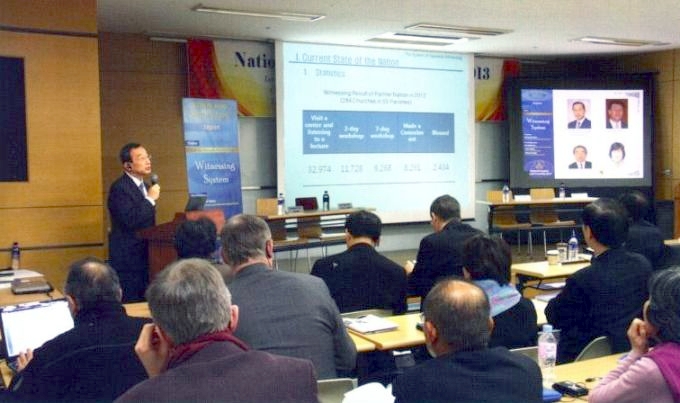
National
Educational Director Yano speaking at NLWA 2013
Eighty-three people attended their first revival in May 2009, fifty-four of them members. The following month they drew 232 people, 178 being members. (Guests had increased from twenty-nine to fifty-four.) After that spike in members' attendance, they settled into the steady grind of trying to hold one revival per month. They did not equal the number of guests for thirteen months, when in July 2010 they brought fifty-seven. They did not draw as many members until December 2010, the month they had 430 people, 135 guests and 295 members. In fact, according to a graph they presented, the members were not able to hold a revival each month. The overall picture shows that they persevered through great difficulty for the first two years.
They began in May 2009 and missed only September that year, averaging thirty-four guests per revival. They held ten Divine Principle revivals in 2010, averaging 39 guests. This included the one in December that attracted 135 guests. For half their 2010 revivals, they had fewer than twenty-five guests. They persisted nonetheless. The revivals helped refresh the spirit of local members as well as guests, and they charged an entrance fee of about Su), providing income for the church and for future activities. After the 430 total in December 2010, they hit 517 in July 2011 and 508 in December that year. Through eleven events in 2011, eighty-seven non-members came on average. In 2012, they held a revival each month, averaging ninety-six non-members per month. They reached 554 (members and non-members) in July and 725 in December.
Once a person has attended a revival more than once, they invite him or her to Divine Principle workshops, which are ongoing each week. They also have many smaller events to bring them to, sports tournaments, music concerts, meals, grape picking and Korean culture- or food-focused get-togethers. Ms. Hyodo explained, "Our final purpose is to share the truth -- Father's teachings and the Divine Principle. But doing only that is not attractive to members or other people, which is why we have other activities, such as a flower-arranging class and a tour to Chung Pyung for liberating ancestors, seniors' meetings and meetings for young people."
They keep good records to guide the progress of their guests. They meet to plan events, hold them and then meet to review how well they executed their plan.
In a rural area where members could not meet people even when they went house to house, the church grew from 191 members when they began these revivals to 304 in December 2012. Their Youth Department had had one member. It now has thirty-four. Some of these young people formed a band that performs regularly. More members have become active and Sunday service attendance has increased 144 percent. They have interacted with some prominent politicians. To reach these results, they persisted through great difficulty.
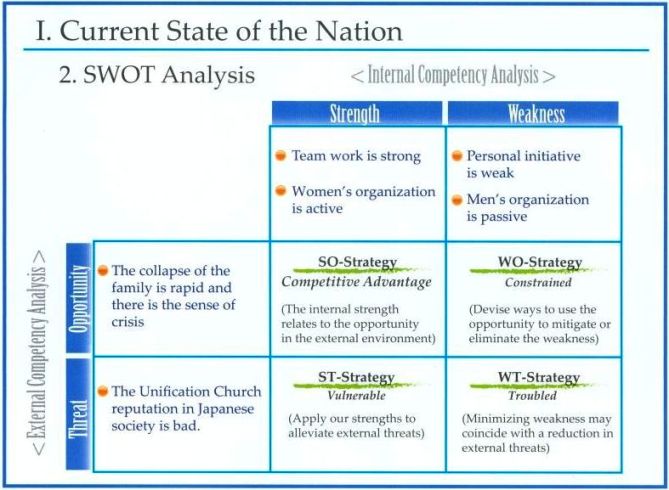
"In Japan," Mr. Yano told the national leaders, "witnessing by engaging people in conversations about religious concepts... is unreasonable in the Japanese societal environment."
In attempting to explain why Japan has attracted so few people to Christianity, Prof. Suzuki Hiroshi, of the International Christian University in Tokyo, used historical factors to describe a nation that closely associates religion with unwanted intervention by its own government and by foreign powers.
"From the middle of the fifteenth century," Dr. Suzuki said, "Japan was in confusion until 1585 or so -- more than a hundred years." He was referring to the Warring States Period, when Japan comprised 260 fiefdoms, each under the control of a feudal lord (daimyo). Neither the emperor nor the military governor (the shogun) was powerful enough to prevent these daimyos from battling each other to expand their territory. He explained, "Spanish trade ships first arrived in Japan in 1543.... Especially guns and other weapons attracted the feudal lords." The foreigners came to Japan and traded weapons and other goods, but they also transported priests, who aggressively sought converts.
Over time, the conversion of Japanese to Christianity and sometimes-unfair trade practices by the foreigners began to rankle. Especially intolerable to Japan's rulers was the Christian teaching that all men were equal under God. In 1614, Shogun Tokugawa Ieyasu (1542-1616) prohibited Christianity in Japan. Many Christians fled Japan and many others were killed. Temples soon appeared where churches had been torn down. In 1616, in tandem with its suppression of Christianity, the shogunate restricted access of Dutch and British ships to two ports and then forbade Japanese ships from trading abroad. In 1639, Shogun Tokugawa Iemitsu (1604-1651) barred all Portuguese ships from visiting Japan. Only limited trade was carried out with ships from China and the Netherlands. This was the beginning of Japan's two-century-long isolation.
In 1853, Commodore Matthew Perry arrived from the United States with four ships in Uraga Bay to attempt to reopen trade with Japan. His imperious performance resulted in what both sides now agree were a series of unequal treaties that nonetheless opened the ports and indirectly led, the professor said, "To the transition from a military regime to monarchism and to a capitalist economy and the establishment of a modern Japanese state system." He went on to say, "A new government launched in 1868. Soon, Protestant missionaries came to Japan to start evangelism." People did convert to Christianity, but some, including influential members of society, were disappointed and started "the non-church movement."
Following World War II, the Japanese people felt betrayed by the military, by their government and by religion, because these three had deceived the people into fighting a much larger nation that they did not understand well and could not defeat. Shintoism had presented the emperor as a deity, a descendant of gods, encouraging emperor-centered nationalism. As Dr. Suzuki put it, because the emperor disavowed his divinity following World War II, "most Japanese, especially those who had education under militarism, lost the basis of life and ideals."
Japan emerged from the war a disillusioned nation. To escape abject poverty, it might be said that hard work became the new god and loyalty to one's company the new religion. Dr. Suzuki points out, "They devoted themselves to their jobs without recovering from spiritual emptiness they experienced by defeat."
Dr. Suzuki told his American audience that day, "Many Japanese do not like the recent history of Japan during World War II, because our country was not humble and imitated the colonialism of the Westerners. Many Japanese feel sorry for the Asians that the Japanese tortured but they do not feel sorry for fighting against the U.S. They view it [as only] not wise to fight against such a strong country.... Japanese like the tragic life of Jesus, but do not like the history of the West, where Christianity is a major religion."
A typical process of how a new member in Japan begins to engage in a personal life of faith was described recently for Today's World readers' benefit. Once a person has made an initial commitment to join the church in Japan, he or she decides from a number of different courses on how they wish to receive a Divine Principle education. This might entail lessons twice a week for sixteen weeks.
In a session, the person would listen to a Divine Principle lecture or watch a video about True Parents' achievements for an hour. Afterward, the learner would attend a session with a counselor or the learner's spiritual parent for more than an hour. This would be a normal conversation about what has been happening that week with the person's spouse or children. If any point of difficulty exists, they would discuss that and perhaps the counselor would ask whether the grandparents are still living, gradually coming to know something of the person's family history or whatever ancestral issues are known. Over the course of sixteen weeks, the person would deal with more than one counselor, but good records are kept. Over time, a clear idea emerges of all the problems and concerns of the person, their family history and background. Based on that, the counselor or spiritual parent begins setting conditions for the new member. Even the director of the video center might do bows to offer conditions for the person and his or her family.
Naturally, personal responsibility is important because later when they have gone through the Blessing Ceremony, the couple will become tribe messiahs, so they have to be responsible. What is important during these sixteen weeks is that the learner develops some framework for completely eradicating the past and making a fresh start. That is the focus.
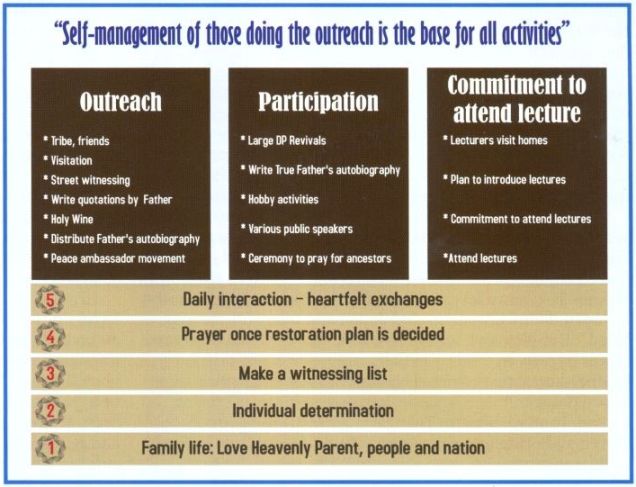
Suzuka borders Ise Bay and beyond that the Pacific Ocean. It is in Mie Prefecture, which is in south-central Honshu, Japan's main island. In 1992, the Suzuka area had only seven members and not much was going on. In 2001, according to Mrs. Toda Ishako, head of the church Wives Association, they connected with members in another area and began witnessing. At that time, they started holding a 9 AM morning departure meeting, at which they sing and share testimonies and then go out witnessing. They have continued that practice to this day. Their region now covers two prefectures divided into twenty-two church districts. Overall, they have 220 members, 70 percent of whom attend Sunday service. They have a church, a video center and two district education centers.
Members in Suzuka begin by distributing As a Peace- Loving Global Citizen and by inviting people to classes. Their ten classes include ones on cooking, painting, dance and yoga. Through these classes, they try to develop strong ties so that they can talk about the Divine Principle later. Pamphlets attract people to the classes and as with all outreach pamphlets used throughout Japan their pamphlets state the church affiliation clearly. The teachers conducting the classes are our members. As they teach, they bring up topics derived from the Divine Principle, such as speaking of vital organs when preparing an animal as food. The teacher may point out how the functions of the organs have parallels in human society, thus suggesting a common creator. Subtly, they try to pique the curiosity of their students.
If a person attending a class decides to attend a Divine Principle lecture but later decides not to continue studying the Principle, he or she is still welcome to continue taking classes and the relationship continues in some form. Two annual focal points for the church in Suzuka are their Summer Festival and Autumn Festival, outdoor events with food booths and displays where they inform the public about their activities.
If a relationship with a person develops because he or she has read As a Peace-Loving Global Citizen, the person is invited to write out the text of the book word for word in the same manner though which fifth-century monks became intimately familiar with the Bible. New contacts are encouraged to come to the church (to develop the habit of coming there) and to write it out side-by-side with others. Later, a ceremony is held to dedicate the finished product to Heaven.
From there or from the hobby classes, if a person begins engaging in the church learning process, in the first month, she or he attends a two-day workshop at the district education center. While learning, the guests are asked to clean or in other ways assist the staff, which helps the person escape the bounds of being simply a visitor. In 2012, 143 newcomers completed a two-day workshop.
In the second month, the person would go through a seven- day workshop. Twenty-two people graduated from this stage last year. Also in the second month, the person would attend a Life of Faith seminar, where they might be asked to act as the emcee, thereby providing their initiation into work as a staff member. Members at this stage begin attending Sunday services.
Twenty people graduated from a Life of Faith seminar last year. From that point on, the new member is encouraged to begin witnessing. From the first through eleventh Life of Faith classes, they have held, forty-five graduates are involved in full-time witnessing.
The various churches in the district supply members to work at the education center. These members care for the guest from their respective cities. They manage the guests' progress through the programs. When a person does not attend a session or workshop, an education center staffer calls to ask why. The center uses this feedback to improve their materials and events.
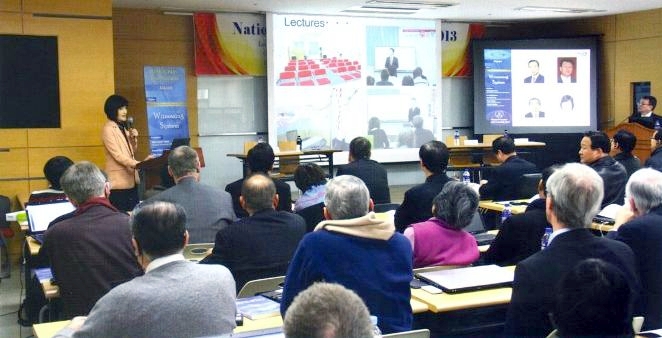
Mrs.
Toda at NLWA 2013; The Japanese groups' slides were well translated
and many contained highly detailed information.
Frontline witnessing is looked at as training for mid-level leaders. Members that have emerged for the first time from a Life of Faith seminar are asked to witness for six hours a week. Communal witnessing for them takes place every Wednesday.
Tuesday evening a text message arrives asking the member to confirm his or her attendance. The leader would pair those who are expected to come and assign them areas. Seventy people usually go out that day, forty-five of them trainees. Some established member would provide homemade snacks for the crucial evaluation meeting after each Wednesday outing.
Among the main body of members, by at least twelve and often by more than twenty people, witnessing occurs every day.
In Suzuka, they believe it is important that the leader recognize that his or her job is management. The leader needs to have a vision and be consistently studying. The leader must have clear goals, a strong sense of responsibility and must never quit halfway. The leader needs good "people skills" and must know how to rejoice and how to rejuvenate others.
Japanese members succeed in part because they choose to follow a harsh course. Frontline members work hard, yet leaders must guide them to face reality squarely and commit themselves. Included in the Suzuka presentation was a member's January journal with a lecturers comments to her:
1/9: When I think about whether I can feel happiness from the original mind (bottom of my heart) and have instant happiness, I have to reflect on myself and how I spend my daily life. While I am listening to a lecture, I feel many regrets. About witnessing to myself and to another person, I do not have such a heart in my daily life. Again,
I repent a lot and try to do my best to grow myself and to help other people grow.
Yearly goals: External -- New spiritual children Internal -- To be able to witness with gratitude, as restoration through indemnity
Comment: Please specify how many people you will bring to the blessing.
Daily goal: Be thankful to give guests life by thinking of them
Comment: Please write specifically what you can be thankful about every day.
1/16: Today, I did not have time, so I did not go around much. I met many men, who mostly made sounds indicating they are reluctant to come. When my feeling is good, I feel I can meet a good person. I always have to check my heart but I want to do my best.
Comment: It is important for you to know what you need to improve clearly. Unless it is clear, you cannot adjust your heart. Please separate yourself from satanic blurring.
Wakayama Prefecture is on the southwestern coast of Japan's main island, Honshu, facing not Korea but the Hawaiian Islands, albeit across 6,400 kilometers of Pacific Ocean. Wakayama is home to nearly a million people dispersed among four-hundred thousand households. FFWPU divides Wakayama into fifty-six areas, in which 824 active members reside.
In Wakayama, members witness based on the tribal messiah concept, using what they call a one-three-nine strategy. This begins with having one happy family that does Hoon Dok every morning. Members of this family raise three model families of spiritual children, who also "gather to read" each morning in their own homes. They, in turn, each persuade three families to join our movement, thereby creating nine "grandchild" families. The members in Wakayama expect that as these model families multiply, changes will emerge in tribes, races, nations and the world.
Members begin by making lists of relatives, friends and neighbors, planning how best to help each gradually reach a point of profound spiritual transformation. They distribute flyers and the Japanese edition of As a Peace-Loving Global Citizen. That the members represent the Unification Church is included on all flyers that our members (throughout Japan) use for outreach.
In Wakayama, rather than using a video center, a traveling lecturer speaks to groups brought together through tribal outreach in the local area, and then larger groups meet for lectures that are more thorough. They have a system in which they gradually educate people. During the first stage, guests are introduced to a life of faith by attending one-, two- and four-day workshops. They take part in a Prayer Ceremony for Restoration (more on this later) and as they do in Suzuka, they transcribe As a Peace-Loving Global Citizen.
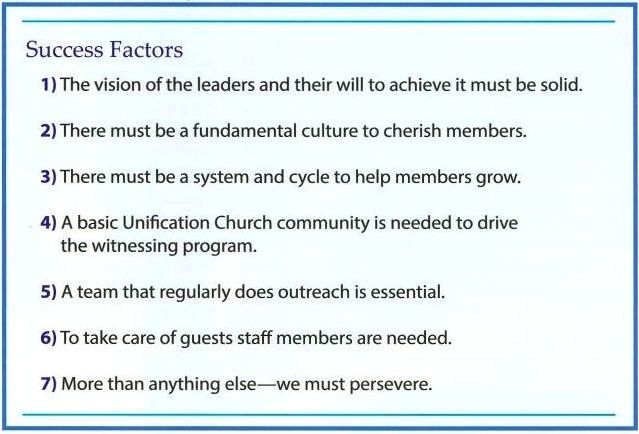
Ancestors are important to most Japanese people in a general way, though not everyone knows the names of ancestors or their life stories. On both the spring and autumn equinoxes, family members go to their ancestral gravesite with a bucket of clean water and a wooden ladle. In the family burial area is a stone with the Chinese characters of the family name on it. Cremation is commonly practiced in Japan. Thus, often little evidence around the stone marker indicates it is a gravesite. (Urns containing ashes are often in a covered recess.) Descendants, using the ladle, pour pure water over the stone marker and pray.
Obon is a time in mid-July or mid-August when instead of your going to visit your ancestors, they come to you. Descendants build small fires near the entrance to their homes to guide them there. Later, when the descendants sense it is time for the ancestors to return whence they came, they built another fire to see them off. This is done by most Japanese people, with the possible exception of Christians who characterize it as worshipping the ancestors.
It is a common practice in Japan to have an altar in the home on which water, rice or other food is offered to one's ancestors. In the home of the oldest son, photographs or drawings of ancestors hang near the altar.
While going through the counseling process during their Divine Principle education, new members begin to see a relationship between their ancestry and their current spiritual situations. In some instances, a local Buddhist temple may have a record of the person's ancestry. Otherwise, companies exist in Japan that can do genealogical research and provide a person with a "family tree" chart.
Japanese members often frame and hang the family tree in their homes and pray daily, choosing a person from their ancestor to pray for by name. If some unfortunate circumstance is known, such as a couple that died childless or a child that died young, families hold a Prayer Ceremony for Restoration, in which prayers are offered and the family members set out a course of bowing or prayer conditions. This is recorded in a "wish paper," on which the member writes, for example, "My grandfather passed away early. It is my wish that he rest well in the spiritual world. I will pray a lot for him."
A section of their presentation illustrated the degree to which Wakayama members deal with the essentials of their daily lives through checklists. Members (including new members at some point) trisect their personal activities into loving heaven, loving humankind and loving their nation and list what personal practices apply to each area. They start with a blank checklist, covering a month, and insert goals into each of the three categories. An example of a checklist in use shows Hoon Dok Hae, 120 bows, daily reflection and report prayer under Love Heaven; various ways of expressing love or affection toward specific people, including praying for ancestors, under Love Humankind; and giving thanks for meals, cleaning various parts of one's home and tithing under Love the Nation. They use symbols indicating that they "did it with heart," "did it" or "couldn't do it."
In Japan, employees in many business enterprises are required to use a checklist and sign it when all the boxes have a check mark. In some cultures, even where the practice has been found to be beneficial, people are reluctant to implement it. In the field of medicine, one doctor at Johns Hopkins Hospital, located in the U.S. city of Baltimore, began developing checklists for simple procedures. One called for nurses to put a check mark to show that he or she had observed a patient for signs of pain at least once every four hours. Untreated pain was thus reduced from 41 percent to 3 percent. Despite improvements in this and other, more serious, areas, medical professionals were at first reluctant to use checklists. When several studies showed sensational results, insurance companies began demanding that doctors and nurses take up the practice.
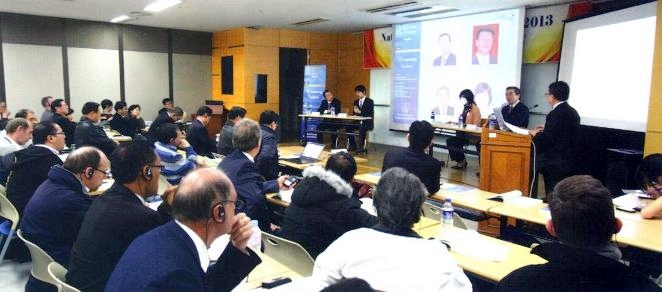
At
NLWA 2013, a panel discussion occurred after the Japanese church
presentation with the Japanese church leaders and their national
education director, at which the moderator, Mr. Jin Hun Yong, asked
sometimes-pointed questions.
Mr. Haruyoshi Yano is in charge of witnessing in Japan. During National Leaders World Assembly 2013, he said the following regarding his observations of how the churches presented in this paper contributed to adding more than eight thousand members to the church in Japan last year.
"The most important thing is the leaders' clear vision and determination to reach goals. Nothing is easy from the beginning, but if the leader is firmly determined without lessening his or her determination for three years, four years, five years, great results eventually come.
"The second point is to take care of our members well. I visited these three churches and talked with leaders and other members there. I felt very comfortable there. It seemed to me that the leaders actually loved their members.
"They have also developed a system, a cycle of education, through which members and guests matured. We are seeing new guests become active members that witness to others. The primary factor is continuity, constant activity without change."
Our family
1. aims to make an ideal family through true love
2. will not be unfaithful or immoral
3. treats our children and grandchildren with true love
4. cooperates to realize world peace
In the terrible disaster of the recent devastating earthquake, many families and people in the area cooperated. Seeing their cooperation left a strong impression on us. The tender heart to think of others and a basic trust relationship grows within a family. That will make a warm society and peaceful country later. We realize that bond will be the core of the family; we think it's important to care for this bond and aim to create true families.
We have read the above, and our family agrees. We will work to make a true family.